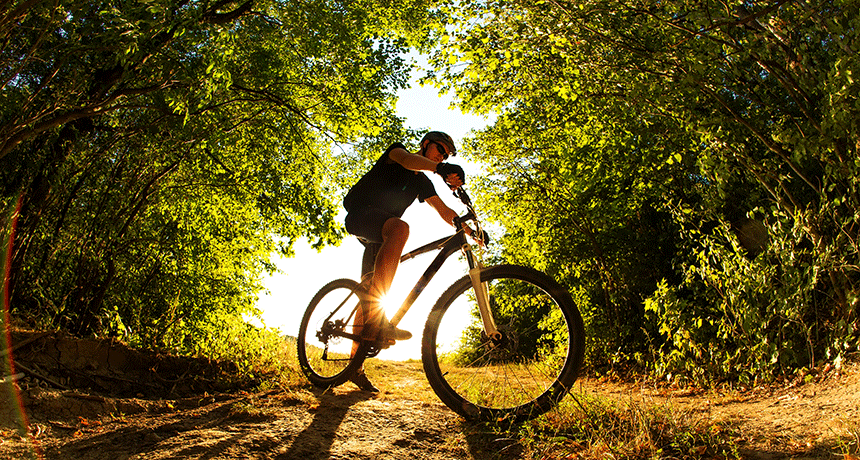Physics guides teen in search for which bike tire is best
Tire size can affect mountain bike speed and agility

Mountain bikes come in several sizes. A teen used science to figure out which size wheels would give him the fastest ride.
aleksey_rezin/istockphoto
LOS ANGELES, Calif. — In competitive mountain biking, speed counts a lot. But on twisting trails, agility is important too. Wheel size can affect both of these factors. But the choice of wheel isn’t obvious. So when Colton Ziemba, 16, was in the market for a new mountain bike, he turned to science to guide his purchase. His experiment showed that for flatter paths, a bigger wheel is better. But when the trails get tough, a smaller wheel can help a biker handle challenging terrain.
Colton is a passionate mountain biker. The junior at Russell Christian Academy in Meridian, Miss., took his results to the Intel International Science and Engineering Fair. Created by Society for Science & the Public and sponsored by Intel, ISEF brought together almost 1,800 high school students from more than 75 countries to show off their research projects. (The Society also publishes Science News for Students and this blog.)
“I would love for more people to get into this sport,” says Colton. “It’s great exercise, and I love doing it.” But when getting into biking, he notes, “mountain bike size is crucial because if you get the wrong size, you’re going to be uncomfortable. You’re going to strain yourself and be sore.” And if that first experience is bad, he worries, “you might never do it again.”
Mountain bikes are sold with many different sizes and shapes of bike frame, but in the United States, there are only two common sizes of bike wheel. The larger wheels are 74 centimeters (29 inches) in diameter, and the smaller are 70 cm (27.5 inches, sometimes called 27 “plus”,). An even smaller wheel — 66 cm (26 inches) — is no longer in favor and hard to find.
Colton hypothesized that the 29-inch wheel would prove faster on a flat surface, but that the smaller, 27.5-inch wheel would do better on twisting trails. “The 29-inch doesn’t have to rotate as much to go the same distance as the 27.5,” he says. On a flatter, straighter road, there are no turns or obstacles, so a 29-inch wheel should be more efficient. On a trail, however, the smaller wheel should be better because it has a lower center of gravity, the teen thought. Objects with a lower center of gravity are more difficult to tip over. So being a little lower to the ground could help bikers stay upright — without losing speed — as they managed difficult turns.

To test his hypothesis, Colton recruited three fellow mountain bikers. They rented six identical bikes, three with 29-inch and three 27.5-inch wheels. This made sure the bikers’ own bikes and preferences didn’t bias their results. Then Colton and his friends each biked two 100-meter (330-foot) courses. One was a flat gravel road. The other was a twisting trail with hills.
The four bikers tackled each course 6 times, biking as fast as they could. For three of the trials, they used a bike with 29-inch wheels. For the other three, they used a bike with 27.5-inch wheels. A fifth person stood by and timed their efforts, noting them down so that Colton would be unable to tell which biker was which. “I’m not sure which rider I was,” he says. “I just hope I’m not rider four because the times for rider four are pretty pathetic.”
On the flat road, all the riders finished within 12 or 13 seconds. On the twisting trail, they crossed the finish line somewhere between 22 and 29 seconds. Wheel size made a difference, Colton found. The four bikers were faster on the flat road with the bigger, 29-inch wheel. But on the trail, the 27.5-inch wheel resulted in faster times.
“The 27.5-inch bike is more comfortable to ride in single track trails, and it’s easier to manage,” Colton says. But he recommends the 29-inch wheel for flat roads and easier terrain. “It’s so much more efficient and so much easier to pedal, just because [the wheel has] a much bigger diameter,” he says.
Other mountain bikers have investigated the physics of bike wheel size. The 29-inch tires may take a little more energy to bring up to speed, they determined, but once there, the biker has more momentum — the force something has as its moving. That makes it easier for the biker to keep moving forward with less effort. But for trails, the 27.5-inch helps bikers through turns. The “29-inch is better for flatter, smoother terrain, and 27.5 is faster on steeper, more technical stuff,” agrees Amanda Batty. She’s a professional mountain biker.
But Batty and Colton both note that personal preference — and a biker’s size — play a big role when choosing a bike. “Smaller people could potentially have a harder time controlling [or] handling a 29-inch as accurately as they might handle a 27-inch,” Batty explains. “It still comes down to preference and individual style, really.”
In Colton’s case, his personal preference for the 29-inch wheels won out. He says, “The more comfortable you are, the more relaxed you are, the faster you go and the more fun you’ll have.”
Follow Eureka! Lab on Twitter







